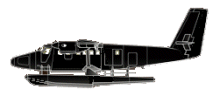Incident Overview

Description
A DHC-6 Twin Otter float plane suffered an accident during a water takeoff from the Dhoores Retreat Resort in the Dhaalu Atoll, Maldives. The aircraft operated on a flight from Mal-Velana International Airport to three water aerodromes in the Maldives before it was to fly back to Mal. The last stop was Dhoores Water Aerodrome. The landing at Dhoores was carried out crosswind, parallel to the swell patterns. The aircraft cast off from the floating platform and 12 the captain gave control to the first officer to taxi the aircraft as he was the nominated Pilot Flying for the sector. According to the flight crew, as the sea conditions were bad, both pilots discussed the best path for the take-off and chose the best possible direction taking the swell patterns into consideration. This path was chosen because the swell effect is usually less prominent nearer to the island. On take-off run the aircraft struck a swell which felt like a small bump, the first officer continued the take-off run and struck the second swell on the right float. On striking the second swell the crew felt that the right float got detached. The aircraft bounced again and came down on the third swell, partially detaching the left float as well. The pilots tried to adjust the speed on every bounce by lowering the nose primarily to ride the swells and avoid heavy impact on the next swell. On impacting the third swell, with the floats already detached, the propellers cut into the floats before the aircraft came to a stop. The captain carried out the engine shutdown procedures and gave the command to evacuate. By this time the cabin crew already had initiated the evacuation process. The first officer then opened the left cabin emergency door and helped the passengers in the evacuation. Causes: “The take-off attempt was made in bad weather, not to the most appropriate direction and with unusually longer swell distances.”
Source of Information
https://raajje.mv/en/news/21537, https://english.sun.mv/46204https://raajje.mv/en/news/21537, https://english.sun.mv/46204Primary Cause
Unsuitable take-off direction and unusually long swell distances.Unsuitable take-off direction and unusually long swell distances.Share on:

